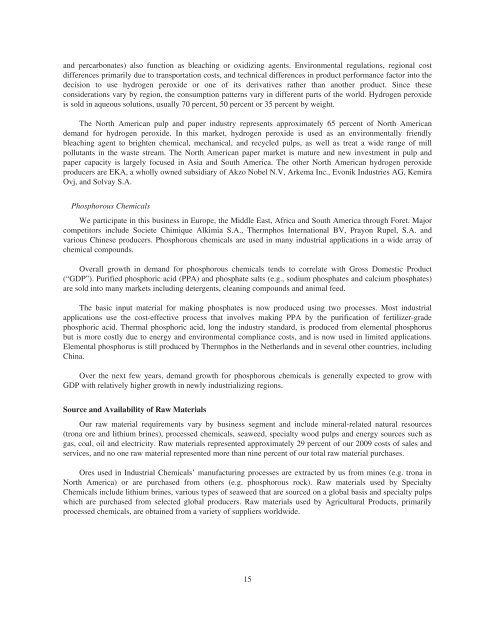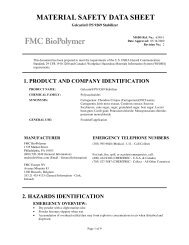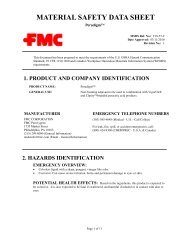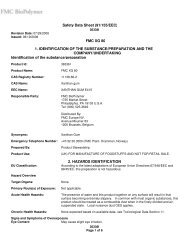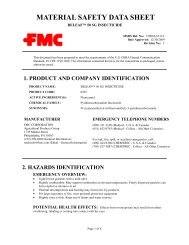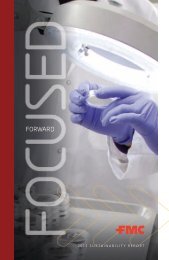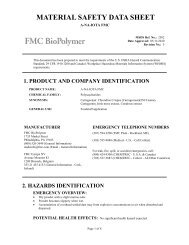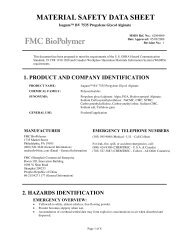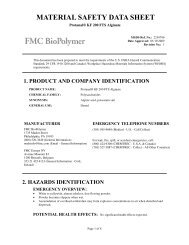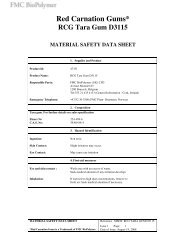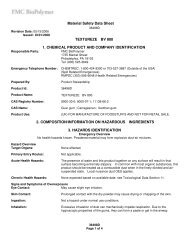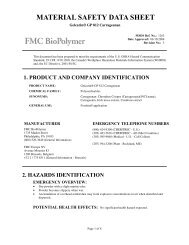Chairman's - FMC Corporation
Chairman's - FMC Corporation
Chairman's - FMC Corporation
You also want an ePaper? Increase the reach of your titles
YUMPU automatically turns print PDFs into web optimized ePapers that Google loves.
and percarbonates) also function as bleaching or oxidizing agents. Environmental regulations, regional cost<br />
differences primarily due to transportation costs, and technical differences in product performance factor into the<br />
decision to use hydrogen peroxide or one of its derivatives rather than another product. Since these<br />
considerations vary by region, the consumption patterns vary in different parts of the world. Hydrogen peroxide<br />
is sold in aqueous solutions, usually 70 percent, 50 percent or 35 percent by weight.<br />
The North American pulp and paper industry represents approximately 65 percent of North American<br />
demand for hydrogen peroxide. In this market, hydrogen peroxide is used as an environmentally friendly<br />
bleaching agent to brighten chemical, mechanical, and recycled pulps, as well as treat a wide range of mill<br />
pollutants in the waste stream. The North American paper market is mature and new investment in pulp and<br />
paper capacity is largely focused in Asia and South America. The other North American hydrogen peroxide<br />
producers are EKA, a wholly owned subsidiary of Akzo Nobel N.V, Arkema Inc., Evonik Industries AG, Kemira<br />
Ovj, and Solvay S.A.<br />
Phosphorous Chemicals<br />
We participate in this business in Europe, the Middle East, Africa and South America through Foret. Major<br />
competitors include Societe Chimique Alkimia S.A., Thermphos International BV, Prayon Rupel, S.A. and<br />
various Chinese producers. Phosphorous chemicals are used in many industrial applications in a wide array of<br />
chemical compounds.<br />
Overall growth in demand for phosphorous chemicals tends to correlate with Gross Domestic Product<br />
(“GDP”). Purified phosphoric acid (PPA) and phosphate salts (e.g., sodium phosphates and calcium phosphates)<br />
are sold into many markets including detergents, cleaning compounds and animal feed.<br />
The basic input material for making phosphates is now produced using two processes. Most industrial<br />
applications use the cost-effective process that involves making PPA by the purification of fertilizer-grade<br />
phosphoric acid. Thermal phosphoric acid, long the industry standard, is produced from elemental phosphorus<br />
but is more costly due to energy and environmental compliance costs, and is now used in limited applications.<br />
Elemental phosphorus is still produced by Thermphos in the Netherlands and in several other countries, including<br />
China.<br />
Over the next few years, demand growth for phosphorous chemicals is generally expected to grow with<br />
GDP with relatively higher growth in newly industrializing regions.<br />
Source and Availability of Raw Materials<br />
Our raw material requirements vary by business segment and include mineral-related natural resources<br />
(trona ore and lithium brines), processed chemicals, seaweed, specialty wood pulps and energy sources such as<br />
gas, coal, oil and electricity. Raw materials represented approximately 29 percent of our 2009 costs of sales and<br />
services, and no one raw material represented more than nine percent of our total raw material purchases.<br />
Ores used in Industrial Chemicals’ manufacturing processes are extracted by us from mines (e.g. trona in<br />
North America) or are purchased from others (e.g. phosphorous rock). Raw materials used by Specialty<br />
Chemicals include lithium brines, various types of seaweed that are sourced on a global basis and specialty pulps<br />
which are purchased from selected global producers. Raw materials used by Agricultural Products, primarily<br />
processed chemicals, are obtained from a variety of suppliers worldwide.<br />
15


